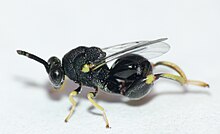| Brachymeria | |
|---|---|

| |
| Adult Brachymeria that has emerged from a pupa of Euploea core | |
| Scientific classification | |
| Kingdom: | Animalia |
| Phylum: | Arthropoda |
| Class: | Insecta |
| Order: | Hymenoptera |
| Family: | Chalcididae |
| Subfamily: | Chalcidinae |
| Genus: | Brachymeria Westwood, 1829 |
| Species: | over 300, see text |
Brachymeria is a genus of parasitic wasps in the family Chalcididae. Over 300 species are known worldwide, all of them parasites of insect pupae. Most species are black with limited yellow markings, and like most chalcidid wasps, they have enlarged hind femora. The female typically lays eggs inside the pupae of a lepidopteran using its ovipositor. Although mostly parasitic on Lepidoptera, a few are hyperparasites (parasites of parasitic Hymenoptera and Diptera), or attack other types of insect larvae (such as Polistes erythrocephalus). The adult parasites emerge typically from the host pupa. Some species have been used in biological control.
References
- Joseph, K.J.; Narendran, T.C.; Joy, P.J. (1973). Oriental Brachymeria: a monograph on the oriental species of Brachymeria (Hymenoptera: Chalcididae). Department of Zoology, University of Calicut.
- Nelson, John M. (1971). "Nesting habits and nest symbionts of Polistes erythrocephalus Latreille (Hymenoptera: Vespidae) in Costa Rica" (PDF). Rev. Biol. Trop. 18 (1–2): 89–98. Archived from the original (PDF) on 2014-10-22. Retrieved 2014-11-12.
This chalcid wasp-related article is a stub. You can help Misplaced Pages by expanding it. |